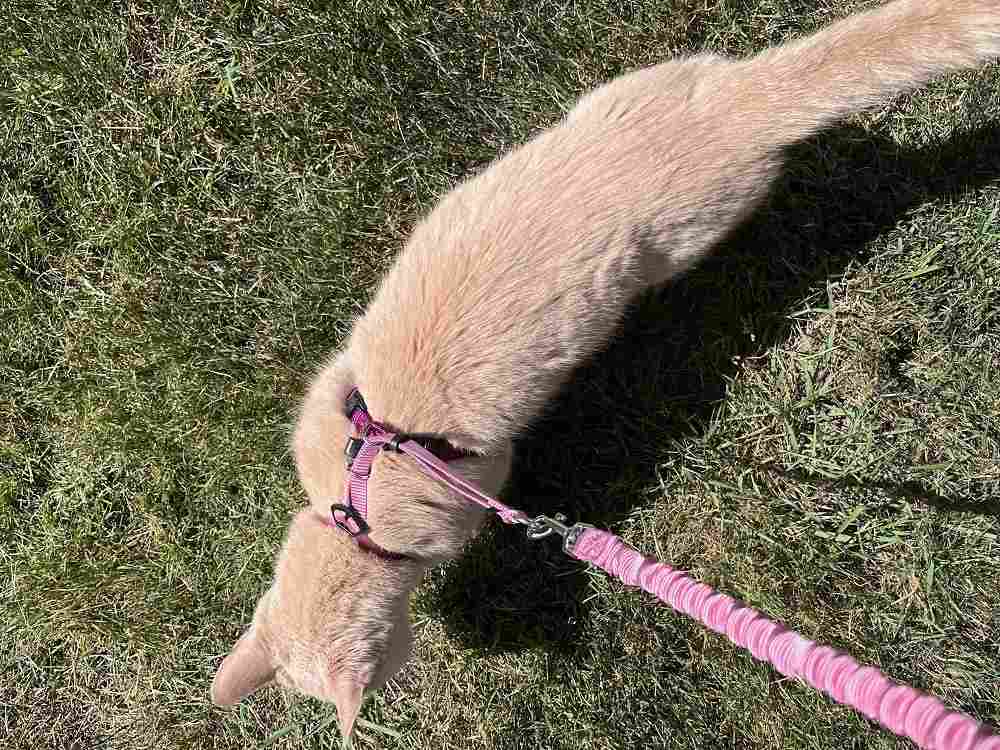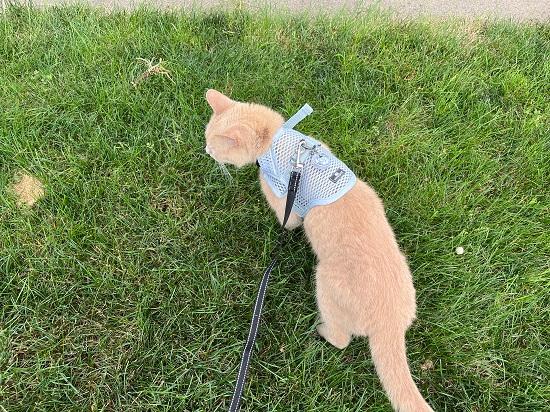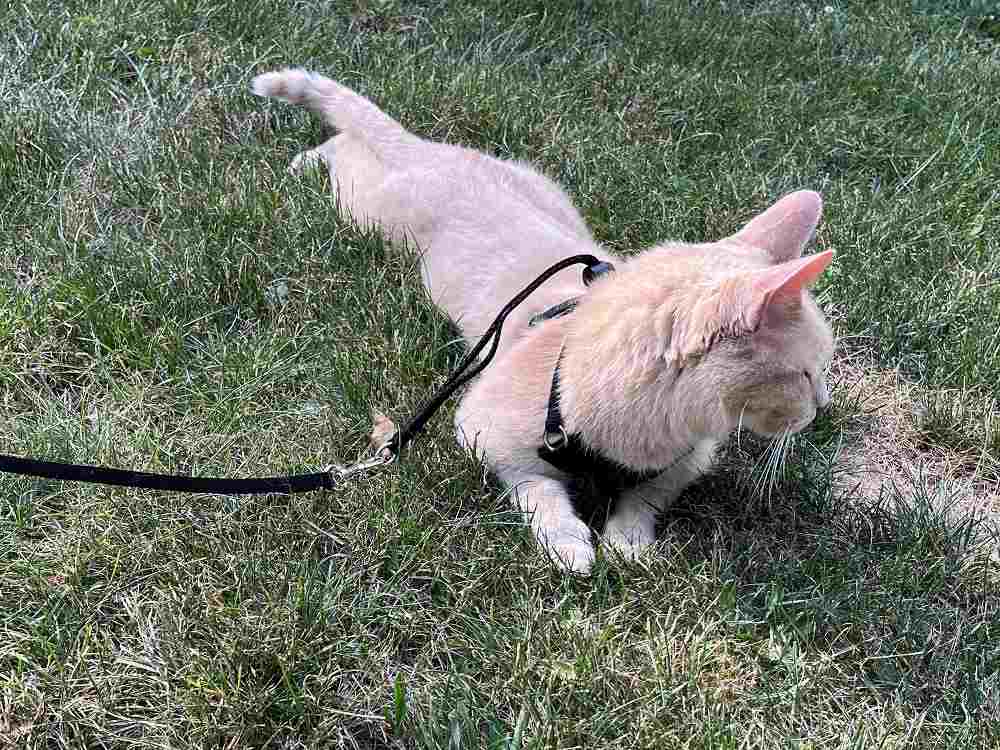
Katelynn Sobus / Cats.com
Many of us want to allow our cats to explore the great outdoors in a safe way. Choosing the best cat harness and taking your cat for daily walks is a great way to add enrichment to their lives. When searching for the best harness, look for durable materials, an escape-proof design, and a comfortable fit. You want it to be easy to take on and off so you aren’t struggling with it each time.
In this article, we’ll discuss why harness training is good for cats, how to know if it’ll work for your cat, and the top cat harnesses on the market today.
At A Glance: Our Top Picks For The Best Cat Harnesses




We highly recommend looking at the comparison table we’ve compiled below where we’ve highlighted the features of each product featured in this review. You’ll also find more detailed information about each product later in the article.

Rabbitgoo Cat Harness and Leash
- Comes with a matching leash
- Cats seem to find it very comfortable
- Four sizes and 13 colors

BEAUTYZOO Cat Harness and Leash
- Matching harness and leash set
- Thick straps
- Two sizes and 10 patterns

Voyager Step-In Adjustable Cat Harness
- Great value
- Matching harness and leash set
- Eight sizes and 24 colors

Pet Safe Come with Me Kitty Harness and Leash
- Adjustable length from neck to shoulders
- Includes a bungee leash
- Three sizes and seven colors

Sleepypod Cat Harness
- Durable mesh fabric
- Secure straps and buckles
- Three sizes and six color variations

Kitty Holster Cat Harness
- Easy to take on and off
- Secure velcro
- Seven sizes and 10 colors

Houdini Escape Resistant Cat Harness and Leash
- Easy to adjust
- Matching harness and leash set
- Three sizes

PUPTECK Soft Mesh Cat Vest Harness
- Easy to take on and off
- Matching harness and leash set
- Four sizes and 15 patterns
Why Should You Harness Train Your Cat?
Cats love the outdoors, but unsupervised outdoor adventures aren’t safe for your cat or the environment. Harness training your cat allows them the mental enrichment that comes from outdoor adventures without the risks of cars, predators, disease, or poisoning.
Harness training isn’t for every cat or even every person. It takes time, effort, and dedication. Once you’ve started taking your cat outdoors, it’s best to stick to a daily routine so they know what to expect.
You’ll also want to guard your doors carefully, especially in the beginning, as some cats will try to escape once they know how much fun they can have outside. Some people prefer not to harness train cats that have never been outside for this reason.
Signs your cat could use the extra enrichment include rowdiness and hyperactivity, boredom, and actively trying to get outdoors. Adventurous cats might love having new places to explore, while more withdrawn cats might be in a rush to get back inside.
However, it’s really difficult to predict how your cat will react without giving them the opportunity. If you’re interested in walking your cat but are unsure if they’ll like it, I recommend buying a cheap but sturdy harness and giving it a try.
Why Trust Cats.com
I’m a lifelong cat owner who harness trained my current eldest cats around 15 years ago. I chose the harnesses on this list based on my own experience, asked other cat owners for their input, and browsed customer reviews to see which harnesses are popular and beloved.
I tested each harness on my two harness-trained cats and observed how they fit, how they looked, if the cats seemed to prefer one over the others, and how the cats moved in them. We went on several 20 to 30 minute outings to test the harnesses thoroughly.
Top Picks Explained
Although we’ve updated our picks since this video was filmed, we still love the products Mallory mentions in this video.
The 8 Best Cat Harnesses
We considered many factors to determine our rankings. Although the Rabbitgoo cat harness is our top choice, every cat and human has their own preferences. To help you choose the best cat harness, we’ve broken down our recommendations by the most adjustable harness, the easiest to put on, and more key considerations.
How To Choose the Best Cat Harness
When purchasing a harness for your cat, you’ll want to keep their preferences in mind. Some cats don’t like thin straps that dig into their fur and skin, while others dislike bulky harnesses that inhibit their movements.
Also consider the safety of the harness and whether it will keep your cat restrained, the durability of the materials, and the comfort and fit of the product.
Security: Cats are much more flexible than dogs and can work their way out of almost any harness given the motivation. That said, some harnesses are more difficult to escape than others. Look for a snug fit and secure clasps.
Durability: Most cat harnesses are fairly sturdy in my experience, but I’m not someone who goes for long, muddy hikes with my cats—we just sit outside for a little while each day. More active cats or those that go on long outdoor adventures will need more durability in their harnesses so that you don’t have to repurchase them over and over. Look for secure clasps and sturdy materials.
Comfort and fit: The right fit is one of the most important things to look for in a cat harness. Always measure the girth of your cat’s neck and chest before buying a new harness so that you can choose the correct size, and make sure it fits snugly before taking your cat outside. You’ll also want to ensure that your cat feels comfortable in the harness and can walk and jump easily while wearing it.
Harness type: The most common harness type is a simple back-clip harness. These have straps that buckle around your cat’s neck and chest and a loop for the leash between the shoulder blades. There are also vest harnesses, which distribute your cat’s weight more evenly if they pull but are also bulkier. Martingale harnesses have a cinching feature at the top that make the harness more escape-proof, but can also be uncomfortable and is considered an aversive training tool.
Frequently Asked Questions
Is it OK to put a harness on a cat?
It’s more than OK to put a harness on your cat, but please introduce it to them correctly. Forcing your cat into the harness makes the experience stressful rather than fun. Take things at your cat’s pace, use treats to guide them close, and teach them to put their head through the front loop themselves. Practice indoor walks first, and remove the harness if your cat is stressed. The entire harness training process can take weeks to months.
Are any cat harnesses actually escape-proof?
Cats are flexible enough to escape harnesses if they want to. Typically, they do so by backing up and stretching out their front legs, allowing the harness to slip over their heads. Training is a much better solution than buying harnesses that claim to be escape-proof. Watch your cat carefully and teach them that the fun ends when they start to back up by carrying them back inside and removing the harness. When walking, try to stay behind your cat and keep them on a short leash. This lessens their ability to back up and escape the harness.
Why can’t cats walk with a harness on?
Cats can walk with a harness on so long as it’s well-fitting. However, a cat not trained to wear a harness might flop to the side, refuse to move, or wobble as they walk. It takes time for a cat to get used to new experiences, and the pressure around their legs can be stressful and confusing. If your cat struggles to walk in their harness, you might need to take several steps back and start the harness-training process from the beginning.
Should a cat harness be tight or loose?
Cat harnesses should fit snugly to prevent easy escape. If the harness is too loose, especially around the chest, your cat will most likely slip out of it. You should be able to fit just one to two fingers beneath the harness, and it shouldn’t slip to the side when worn. At the same time, it shouldn’t pull your cat’s neck back uncomfortably or prevent natural movements (though many cats will walk funny when first wearing a well-fitted harness).
-
https://dariuszzdziebk.wpenginepowered.com/wp-content/uploads/2020/09/Doherty-et-al.-2016-Invasive-predators-and-global-biodiversity-loss.pdf





































